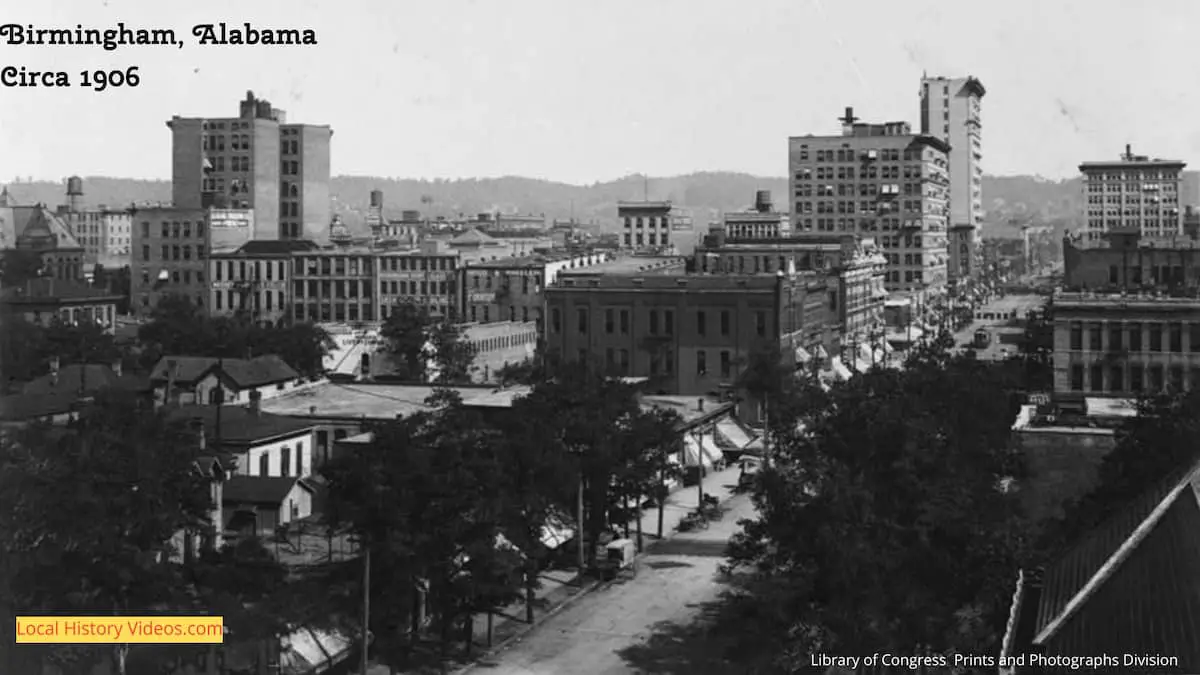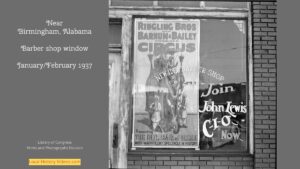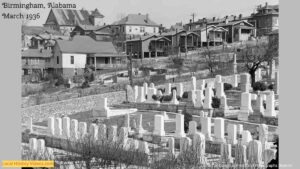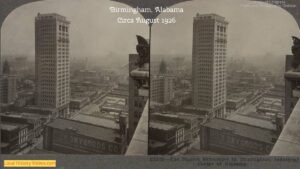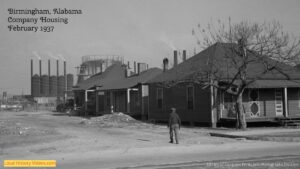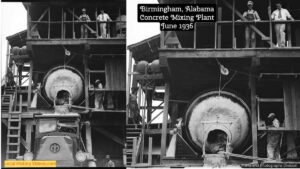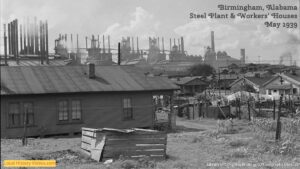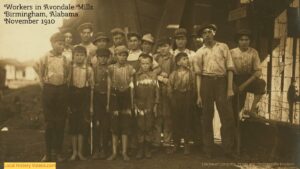Glimpse history through old photos and vintage film of Birmingham, Alabama, in the United States of America.
Old Photos of Birmingham, AL



































Birmingham, AL in the 1920s & 30s
































Changing Times for Birmingham, AL






















When was Birmingham Alabama Founded?
Birmingham Alabama was founded on June 1 1871, by the Elyton Land Company. They were selling land lots at the planned crossing of the Alabama & Chattanooga and South & North Alabama railroads, along with part of the Benjamin P. Worthington plantation.
What was Birmingham called before?
Elyton was one of several towns near the planned crossing of the Alabama & Chattanooga and South & North Alabama railroads which were eventually absorbed into the growing city of Birmingham in 1911. The Elyton Land Company originally founded Birmingham and sold the land lots there, marketing it as a planned centre of industry.
Who named Birmingham Alabama?
Birmingham Alabama was named after the great industrial city of Birmingham in the West Midlands, England. The Elyton Land Company was selling land lots, and marketed the newly founded city as a planned centre of industry, which attracted buyers.
Who were the Elyton Land Company?
The Elyton Land Company was a group of investors. They included cotton planters, bankers and railroad entrepreneurs.
What was the first business to open in Birmingham Alabama?
The first business to open in Birmingham Alabama was Marre & Allen, a trading post and country store.
The 3 important mineral deposits of Birmingham Alabama
Birmingham Alabama is the only place in the world where the three main raw ingredients of steel making – iron ore, coal and limestone – are all found in close proximity, and all three are within a ten mile radius. In 1871, this heralded the chance to make a great industrial city.
Old Photos of Birmingham, Alabama
Old Photos of Birmingham (Alabama)1900-1916 – oldstuff4all on YouTube
What events impeded the growth of Birmingham Alabama?
The first two years of Birmingham Alabama saw an outbreak of cholera, and then the Wall Street Crash of 1873 had financial consquences for the newly estabished city. But these events were quickly overcome, and by 1912 the city was home to a group of early skyscrapers.
Why was Birmingham Alabama called The Magic City?
The Magic City referrred to Birmingham Alabama because the city grew from a low-rise commercial and residential district in 1902, to a mid and high-rise collections of large office blocks, warehouses and industrial facilities by 1912.
The Heaviest Corner on Earth
By 1912, Birmingham Alabama was home to four large neoclassical office buildings at the intersection of 20th Street (the central north–south spine of the city) and 1st Avenue North (which connected the warehouses and industrial facilities stretching along the east–west railroad corridor).
The 1916 Irondale Earthquake
Birmingham Alabama was hit by the 1916 Irondale earthquake, which had a magnitude of 5.1 and was felt in Atlanta and neighbouring states. Luckily, its impact was limited to slightly damaging some of the city’s buildings.
Birmingham in the 1900s
Birmingham in the 1900s – Alabama Pioneers on YouTube
The Great Depression of the 1930s
In the 1930s, land labourers were driven off the land and into cities, including Birmingham, to look for work. Unfortunately, this coincided with Birmingham’s minerals rapidly drying up, which meant the city lost the mainstay of its economy.
Many of the city’s residents found work through the New Deal programs, including the WPA and CCC programs. Key benefits for the city included Vulcan’s tower and Oak Mountain State Park.
1930’s Birmingham, Alabama
The city was home to more than 250,000 people when this footage was recorded in the 1930s, about 20% more than in 2021.
The minerals industry in the Birmingham district was providing a third of all state taxes. Increasing people and cars was causing concern, leading to investment in the state park so residents could relax in fresh air.
Birmingham, Alabama industrial city beautiful film from the 1930s – Alabama Pioneers on YouTube
PostWar Birmingham Alabama
The postwar period brought renewed prosperity to Birmingham Alabama, as the city’s steel was back in high demand for the post-war building boom. The city also expanded its industrial base, with manufacturing diversifying beyond the production of raw materials.
It was also a period of growth and development for the city’s schools, parks, and museums.
What happened in Birmingham Alabama in 1963 and why was it important?
Bimringham Alabama has always had a community of black workers and residents. But their rights to equal participation in the democratic system were restricted, and the allocation of one seat in the senate to each county gave undue influence to rural counties.
Alabama also operated the state and local statutes that legalized racial segregation, known as the Jim Crow laws.
As a result, Birmingham was one of the key locations of the civil rights movement in the 1950s and 1960s.
Between 1947 and 1965, 50 dymaite explositions targeted the homes of Afro-Americans attempting to move into entirely white residential areas, and later anyone connected with attempts to end segregation. It earned the city the name ‘Bombingham’, and one area of the city ‘Dynamite Hill’.
In 1963, the preacher and co-founder of the Southern Christian Leadership Conference, Fred Shuttlesworth, invited Martin Luther King, once a pastor in the city, to return to Birmingham to help end segregation.Shuttleworth and King launched ‘Project C’ (C for Confrontation).
In April and May 1963, James Bevel organised and led daily sit-ins and mass marches for Project C, which continued despite police repression, tear gas, attack dogs, fire hoses, and more than 3,000 arrests (almost all of them high-school children).
Dr Martin Luther King was imprisoned for having taken part in a non-vioent protest. There he wrote the famous Letter from Birmingham Jail, arguing that black Americans had waited long enough for equal rights, and that unjust laws were invalid laws.
The bombing of the 16th Street Baptist Church on September 15, 1963, killed four young girls:
- Addie May Collins, aged 14
- Carole Robertson, aged 14
- Cynthia Wesley, aged 14
- Denise McNair, aged 11
16th Street Baptist Church
16th Street Baptist Church Bombing Survivor Recalls Attack 58 Years Later – MSNBC on Youtube
The following year saw the passing of the Civil Right Act of 1964.
In the early 1970s, a fereal court case enforced the voting rights to ‘one man, one vote’.
New Skyscrapers
Birmingham has seen a large movement of people moving out to the suburbs over the past 50 years. In 2020 Birmingham was no longer the largest city in Alabama, with the population of Huntsville now larger.
But the city also seen great improvements over the past few decades.
1970s
- The University of Alabama at Birmingham developed into a major medical and research center
- Upgrading of vulcan Park
- construction of a major downtown convention center containing a 2,500-seat symphony hall, theater, 19,000-seat arena and exhibition halls
- Banking industry grew
- First new skyscrapers since the 1970s
2011
- The Highland Park neighborhood of Birmingham was named as a 2011 America’s Great Place by the American Planning Association
2022
- The 11th edition of The World Games took place from 7th to 17th July 2022 in Birmingham, Alabama, so they were known as Birmingham 2022.
More about Alabama
- Labor Rights in Old Birmingham, AlabamaThe labor movement in Birmingham, Alabama, has been a significant part of the city’s industrial history, characterized by a struggle for workers’ rights, labor organization, and social justice.
- Birmingham, Alabama in the 1930sStep back in time to 1930s Birmingham, Alabama, a vibrant city struggling with the impact of the Great Depresssion.
- Birmingham, Alabama in 1926By 1926, Birmingham, Ala., was at the height of its industrialization and a dynamic, modern place to be.
- The Finley Roundhouse at Birmingham, AlabamaThe Finley Roundhouse was an important part of railway history in Birmingham, Alabama. Abandoned and derelict, its roof was destroyed by a hurricane.
- Company Housing in Old Birmingham, AlabamaAs workers migrated into the expanding city of Birmingham, Alabama the company houses were in high demand.
- Making Concrete in Old Birmingham, AlabamaConcrete was an essential part of growing the city and industries of Birmingham, Alabama.
- The Steel Industry in Birmingham, AlabamaDiscover why steel was such an important part of the local economy in Birmingham, Alabama, USA.
- Old Photos of the Workers of Mobile, AlabamaGlimpse history through old photos of adults and children at work in Mobile, Alabama, USA.
- The Child Workers of Birmingham, AlabamaDiscover the haunting old photos of children who worked in the factories, eateries, messaging and transportation industries of Birmingham, Alabama.
- Old Images of Mobile, AlabamaGlimpse history through old images of Mobile, in Alabama, USA.

